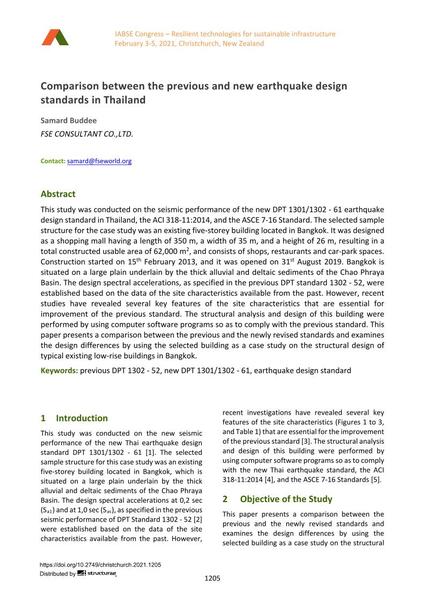Comparison between the previous and new earthquake design standards in Thailand

|
|
|||||||||||
Bibliografische Angaben
| Autor(en): |
Samard Buddee
(FSE CONSULTANT CO.,LTD.)
|
||||
|---|---|---|---|---|---|
| Medium: | Tagungsbeitrag | ||||
| Sprache(n): | Englisch | ||||
| Tagung: | IABSE Congress: Resilient technologies for sustainable infrastructure, Christchurch, New Zealand, 3-5 February 2021 | ||||
| Veröffentlicht in: | IABSE Congress Christchurch 2020 | ||||
|
|||||
| Seite(n): | 1205-1213 | ||||
| Anzahl der Seiten (im PDF): | 9 | ||||
| DOI: | 10.2749/christchurch.2021.1205 | ||||
| Abstrakt: |
This study was conducted on the seismic performance of the new DPT 1301/1302 - 61 earthquake design standard in Thailand, the ACI 318-11:2014, and the ASCE 7-16 Standard. The selected sample structure for the case study was an existing five-storey building located in Bangkok. It was designed as a shopping mall having a length of 350 m, a width of 35 m, and a height of 26 m, resulting in a total constructed usable area of 62,000 m², and consists of shops, restaurants and car-park spaces. Construction started on 15th February 2013, and it was opened on 31st August 2019. Bangkok is situated on a large plain underlain by the thick alluvial and deltaic sediments of the Chao Phraya Basin. The design spectral accelerations, as specified in the previous DPT standard 1302 - 52, were established based on the data of the site characteristics available from the past. However, recent studies have revealed several key features of the site characteristics that are essential for improvement of the previous standard. The structural analysis and design of this building were performed by using computer software programs so as to comply with the previous standard. This paper presents a comparison between the previous and the newly revised standards and examines the design differences by using the selected building as a case study on the structural design of typical existing low-rise buildings in Bangkok. |
||||
